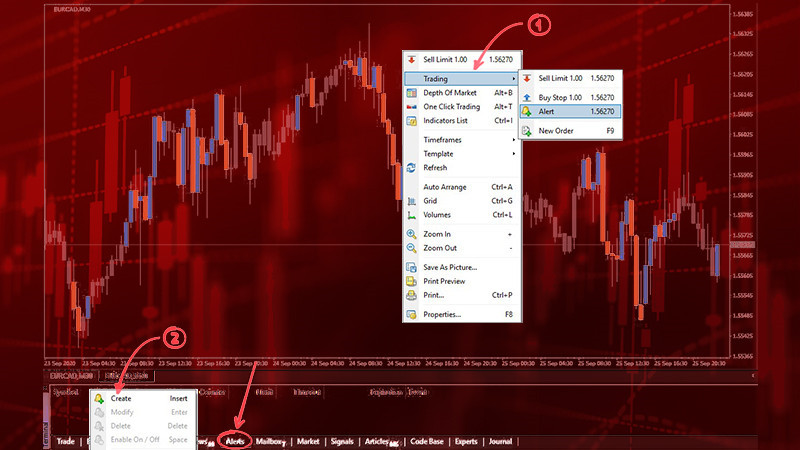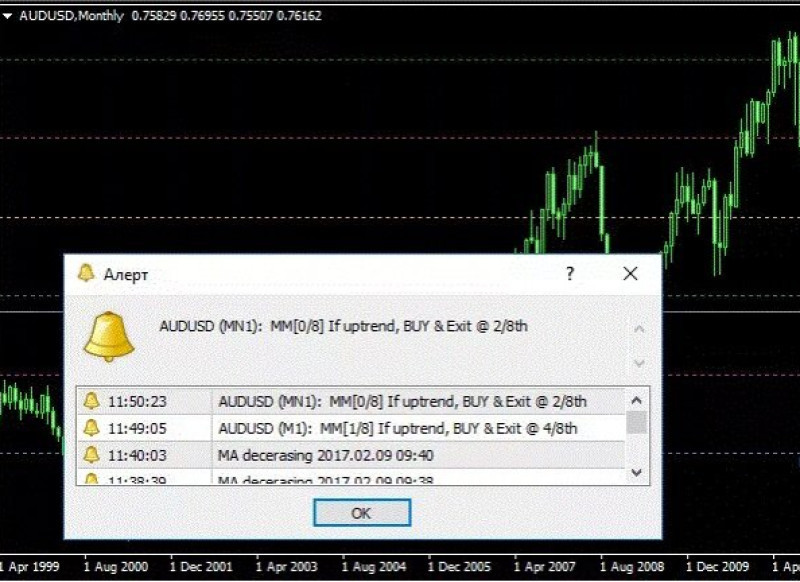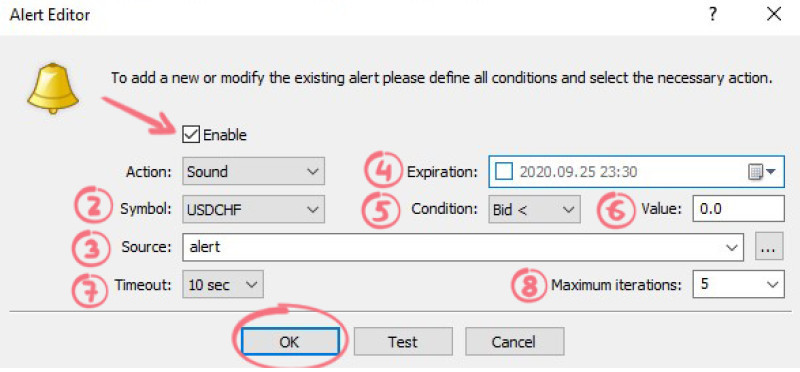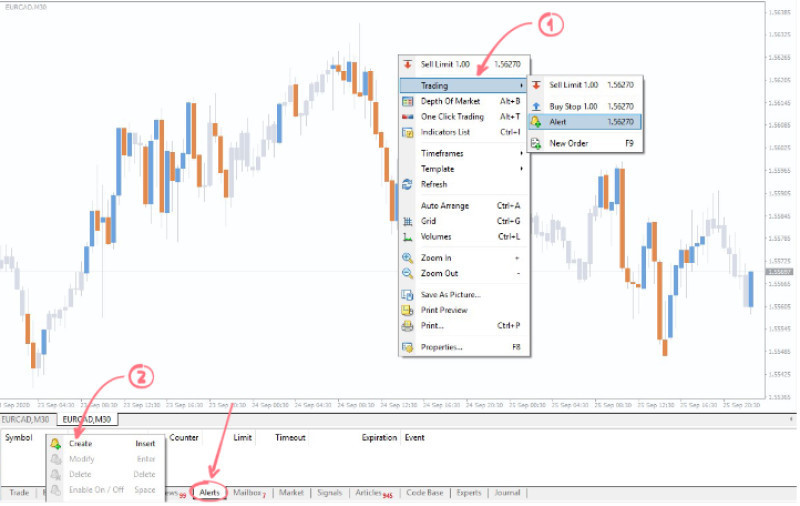
There are three things you can watch endlessly: fire burning, water flowing, and the asset's price changing constantly. While the first two phenomena bring peace and serenity, the latter is a bit more complex. Financial markets are influenced by a myriad of factors affecting asset prices.
Even the most attentive and dedicated market participant can not always keep track of an asset’s value and catch the most advantageous price on the timeframe*. After all, traders have many other important matters requiring their attention.
And we haven't even started discussing the endless list of external factors constantly impacting market quotes. No matter how closely you monitor market volatility* and apply precise mathematical calculations for price behavior analysis, you can never be 100% sure about the future movement of chart indicators.
Unfortunately, an asset’s value is not a static figure. It represents the real interplay of supply and demand, heavily influenced by the economic and political climate.
Significant fluctuations in quotes at any moment can be triggered by changes in state monetary policies, investor reactions to recent economic and geopolitical events, news backgrounds, fresh macroeconomic statistics, and even wars, pandemics, and climate disasters.
Moreover, exchanges also experience force majeure events or "black swans." Situations like delisting, exchange hacks and asset thefts, or the bankruptcy of a founder* are examples of such events.
Sounds complex and daunting, doesn’t it? However, there is a solution. Fortunately, modern technologies are continually advancing, and trading experts have devised a lifesaver for market participants against most of the problems mentioned above. We are talking about alerts.
*Timeframe refers to the time interval used to group quotes in the process of constructing price chart elements of a trading asset.
*Volatility is a statistical indicator reflecting the degree of price change of a traded asset. In other words, it's the difference between the maximum and minimum prices formed over a certain chart segment.
*A black swan, a term first coined by Nassim Nicholas Taleb in 2007, signifies unforeseen, inevitable, and rare economic, political, and social disasters with unique characteristics and significant global implications.
*Delisting is the removal of a traded asset from the list of available trading options on an exchange.
*A founder is an initiator of a company or the person who conceived/launched a startup.
What are alerts on MT4?
Before diving into how to set up an alert on MT4, it is crucial to understand what an alert is, along with its features and capabilities. An alert is a notification function alerting the user to market events. Through alerts, a trader can set conditions upon which the trading platform will automatically send notifications about the occurrence of a predetermined event.
How does it work? The user's terminal emits a sound, a pop-up window appears on the PC monitor, or a text message shows up in the graphical area. Additionally, in MetaTrader 4 settings, you can choose to receive the signal as an email or an SMS on your mobile phone. The notification is sent the moment the preset condition occurs. Alerts can be set for any financial market of interest, be it Forex, stocks, precious metals, cryptocurrencies, etc.
Since price changes are of utmost interest to traders, they often receive notifications when an asset reaches a pre-specified price level. This way, market players stay informed about the price changes of their financial instruments while attending to other matters.
However, alerts offer more than just the ability to track asset prices. Let’s explore the other capabilities of these trading assistants:
- They help in optimally buying and selling assets and in fixing profits.
- They allow traders to analyze trading instruments.
- They enable the setting of multiple sound commands for key currency pairs.
- They provide working recommendations for trading.
- They offer directions on the current market trend.
- They suggest the best quotes for market entry, as well as take-profit* and stop-loss* levels relative to a trade.
- They work in tandem with push notifications that the MetaTrader 4 app sends to the user's mobile device. Using these two tools together, you won't miss a crucial market moment.
- They allow the application of all functions that traders are accustomed to using on regular orders*. For example, you can change the color or access the settings menu with a double mouse click.
- They feature a wide variety of sound files, so you can always choose the perfect alert sound to accompany you.
Considering such a broad range of alert capabilities, don’t jump to the conclusion that endless notifications will constantly disturb you. You can always turn off this feature or modify its parameters and conditions to suit your needs.

*Stop-Loss is a type of market order (a pending order) for the automatic closure of a trade at a pre-specified level in case of a fall or reversal in the asset’s value. Simply put, a stop-loss helps a market player limit potential losses on a trade.
*Take-Profit is a market tool that acts as an order (a pending order) to fix profits in the event of an asset’s price increase.
*Order is a specific instruction from a trader to a broker to buy or sell a certain amount of financial assets.
Advantages and disadvantages of alerts
The benefits of alerts in modern online trading are hard to overstate. Many traders confidently claim that since they started actively using these notifications, their trading has become much more comfortable, successful, and profitable.
However, let’s highlight a few key reasons why you should set up an alert on MT4 as soon as possible. So, what makes these alerts so beneficial?
Firstly, they help effectively combat the psychological factor that hinders market players from earning maximum profit.
Often, the main trading goal for traders is to seize every opportunity without losing a second. They operate on the principle of "advance, not retreat." Such players enter the market as soon as the asset price moves in the desired direction, aiming to instantly lock in even a small profit. This is a more aggressive trading style, accompanied by additional risks.
More cautious market players opt for a strategy of patient waiting. They are ready to sit through a price dip for hours, sometimes even days, waiting for the traded asset's value to return to the opening position level.
It's important to note that even such deliberate trader behavior does not guarantee endless profit and the absence of losses. During the process (sometimes very lengthy) of waiting, many attractive trading opportunities are missed.
However, when deciding to adhere to this strategy, it's important not to make impulsive actions and remain as calm and confident as possible.
Regardless of which market player category you belong to, an alert will be an indispensable assistant in market entry. By choosing this tool and opening a position, you can relax about sudden changes or the need to make urgent, spontaneous decisions.
Simply minimize the notification window from the MetaTrader 4 trading platform and wait for either the trade to close or a signal from the indicator* about a trend reversal*.
Even in this case, it's important to weigh all the pros and cons, not forgetting about risk management* rules.
If we talk about the second key advantage of alerts, it is undoubtedly filtering. Utilizing numerous technical analysis* methods, traders sometimes simply can’t keep up with everything they need for profitable trading.
This is where alerts come into play. Their use helps market players avoid missing important signals for them and allows shifting some of the functions of working with timeframes to alerts.
Then these MT4 tools start functioning as unique entry filters, based on the trader-developed algorithm for making a trade. At a certain moment, the user receives a loud audio or a vivid visual alert that will not be lost among multiple charts and helps not to miss the entry point.
Above, we have thoroughly discussed the two cornerstone advantages of alerts. Now, let's briefly list more obvious but equally important pluses.
Automatic notifications have earned their popularity and tender love from many traders due to their stability and reliability. Today, market players can step away from their computer monitors without fear for their trading results, freeing themselves from the constant need to track changes on timeframes.
The hunt for the perfect market entry moment can be confidently entrusted to alerts. You can return to trading and fully immerse yourself in the world of making deals only when the signal has been activated.
In practice, traders worldwide commonly use alert notifications in the following four situations:
- When unwilling to trade within a price range.
- When awaiting a price level breakout.
- When trading at the opening of markets (New York, London, Frankfurt, etc.).
- Just before the release of important economic and geopolitical news.
Audio and visual notifications enable traders to efficiently plan their workday while staying informed about the most important events in financial markets. Alerts become their sort of assistants and personal aides, whose work doesn't require payment.
As for reliability, notifications from MetaTrader 4 are highly sensitive to even the slightest fluctuations in quotes and guarantee instant reaction when the user-set criteria are met. The main rule here is to correctly set up the parameters to ensure uninterrupted and accurate alert functioning.
The simplicity of using these signals cannot be overstated. This trading tool is intuitive and extremely easy to use. Setting them up on a chart takes only a few minutes, and even market novices won't find it challenging. Importantly, using alerts does not require knowledge of MQL4* and MQL5.*

If we talk about the drawbacks of alerts, this is the rare case where there simply aren't any. It's crucial to understand, however, that alerts from the terminal are not a trading system guaranteeing 100% profit to the speculator*. Alerts are more of an additional tool that makes the trading process more comfortable, simple, and unburdened.
However, one should not overuse alerts. When there are too many audio and visual signals, they can start blending together, hindering rather than aiding effective trading. Therefore, it's better to differentiate alerts between assets, for example, by setting a separate sound signal for each currency pair.
*Indicators are tools used for analyzing and forecasting price changes in financial markets. In other words, they are calculations based on the volume of a particular trading instrument and its prices.
*Trend reversal is a market situation where the general direction of price movement changes from downward to upward or vice versa. Horizontal lines marking the points of a reversal help identify key levels that can provoke a change in price.
*Risk management is a set of rules that help a trader determine the volume of investments to enter the market with and the acceptable size of financial losses.
*Technical analysis is a collection of tools that allow a trader to assess the current situation in the financial market and forecast its possible changes using statistical patterns in asset price movements.
*MQL4 is a programming language for the MetaTrader 4 trading platform. With MQL4, terminal users can create trading robots, indicators, and other tools that significantly expand the possibilities of trading in global financial markets.
*MQL5 is a platform containing many useful services for users of MetaTrader 5 and MetaTrader 4 terminals. The primary purpose of MQL5 is the quick and efficient resolution of traders' issues and tasks using technical analysis tools. Users most often use this platform to create applications for automatic analysis and online trading.
*A speculator is a player in global financial markets who earns on the price difference between buying and selling an asset in short positions.
Setting up alerts on the platform
Before discussing how to set up an alert in MT4, it's important to note that there is no need to download alerts, as they are automatically integrated into the MetaTrader 4 platform. Now, let’s move on to the detailed instructions for setting up alerts in the terminal:
- Adding an alert to the chart: right-click in the timeframe window and select "Trading" → "Alert" from the menu.
- Wait for the appearance of a red dotted line: this line appears automatically at the cursor's location when you click on it, and it represents the level at which the alert is set. Don't worry, you can adjust this level later in the "Terminal" settings window.
- Find the necessary tab in the trading platform, double-click on the created alert instrument and choose your settings in the editor. Alternatively, you can invoke the editing mode by directly clicking on the arrow.
- Customize your preferences: you can choose the frequency and number of sound signals that suit you. Additionally, in the settings, you can select the validity period of the message, i.e., set a date after which the signal will cease.
- Confirm the alert creation: once you have configured all the necessary functions and parameters of the alert, confirm the creation of the notification by pressing "OK".
- View active alerts: the list of active alerts will be displayed in the "Alerts" tab of the trading platform window.
Managing alerts
As you can see, setting up audio and visual signals in MT4 is a relatively simple and quick process. However, before you start trading with these tools, it's important to properly configure them using the context menu commands.
Here's an important note: to manage alerts using the keyboard, you need to focus on the working window. Do this by clicking on the window with the left mouse button.
- Create: This setting is used to create a new alert.
- Modify: This function allows you to edit an alert. You can achieve the same result by double-clicking the left mouse button on the alert information line.
- Enable/Disable: With these functions, you can turn an alert on or off.
- Delete: This option allows you to remove an alert. You can also use the "Delete" key or right-click in the MT4 terminal and select the corresponding command.

Setting up alerts on mobile devices
If you are so inspired by alerts that you'd like to have this handy tool with you at all times, here's how to set up MT4 signals on your smartphone. It's important to note that the mobile version of MetaTrader needs to be linked to the desktop terminal. This way, you can receive important alerts on your phone while going about your daily activities.
- For iOS:
- Open the MetaTrader mobile app and go to Settings.
- In the Settings, select "Chat and Messages."
- A MetaQuotes ID, an eight-digit identifier, will appear on the screen, which you need to enter into the PC-installed program.
- In the desktop terminal, select "Tools" → "Options."
- In the Settings, go to the "Notifications" tab.
- Check the boxes next to "Enable push notifications" and "Notify of trade transactions."
- Enter the MetaQuotes ID in the appropriate field.
- After setting up, the mobile app will request permission to send push notifications. Press "OK" to save the settings.
- For Android: The process for setting up notifications is similar, with the only difference being that the eight-digit MetaQuotes ID is found in the "Messages" tab.
Final thoughts
Today, we have delved into an important and useful topic for every trader - "How to Set an Alert in MT4." Despite the technical nature of our review, much of it was devoted to the advantages and features of notifications in MT4.
It is hard to overstate the efficiency of alerts for the modern trader in our fast-paced world. Alerts are convenient, practical, simple, and most importantly, profitable. Their function of signaling even the slightest change in the price of a traded asset helps users significantly improve their trading and increase the chances of making profitable deals.
Certainly, the skill of many experienced traders has reached such heights that they can keep track of any market movement and remember every change in quotes. But why do you need to overload yourself with information when all this can be done for you by an alert in MT4? You can spend this time without worry, enjoying other pleasures of life.
When a set price is reached or important news breaks, your computer or smartphone will definitely inform you about it.
Remember, the number of alerts is not limited. With their help, you can be prepared for any market behavior and be aware of any event happening on it. It's time to take advantage of the useful functions of your trading platform and significantly ease your trading routine!
You may also like:
How to install an indicator in MT4
How to add expert advisor in MT4
How to install two MT4 terminals








 Back to articles
Back to articles



